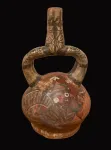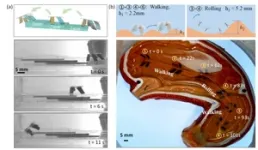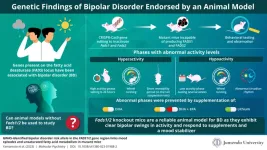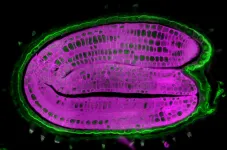(Press-News.org) Color plays a huge role in our lives — the hues we wear and decorate with are a way for us to signal who we are, where we’re from, and what we care about. And it’s been that way for a long time. In a new study in the Journal of Archaeological Science: Reports, archaeologists compared the colors on pieces of ancient Peruvian pottery. They found that potters across the Wari empire all used the same rich black pigment to make ceramics used in rituals: a sign of the empire’s influence.
The Wari empire spread over Peru’s highlands and coastal areas from 600-1050 CE. “People sometimes think of the Inka as the first big empire in South America, but the Wari came first,” says Luis Muro Ynoñán, the study’s corresponding author and a research associate and former postdoctoral scientist at the Field Museum in Chicago.
The Wari didn’t leave behind a written record (or at least a system similar to the one we use now). “Since they didn’t use writing, material culture — things like pottery — would have been an important means for conveying social and political messages,” says Muro Ynoñán. “The visual impact of these objects would have been super powerful.” Even little details, like using the correct shade of a color, could help signify an object’s importance and legitimacy as a part of the empire.
“I remember seeing some of these Wari-influenced pots as an undergraduate archaeology student in Peru, they're fascinating,” says Muro Ynoñán. “The rich black color on them is very distinctive, I’ve been obsessed with it for years.” Muro Ynoñán finally got to pursue his interest in the pigment in-depth during his postdoctoral position at the Field Museum.
He and his co-authors, including Donna Nash, an adjunct curator at the Field and associate professor and head of anthropology at the University of North Carolina Greensboro, examined pottery from different regions under Wari influence, focusing on the chemical makeup of the black pigment used.
The exact formulation of pigments varied from site to site, but overall, there was one striking similarity: many of the Wari pots examined in the study used black pigment made from minerals containing the element manganese.
“Some of the sites, specifically in northern Peru,used a different recipe for black, using iron- and calcium-rich minerals, before the Wari arrived, but after the Wari took over, they switched to the manganese-based recipes,” says Muro Ynoñán. The shift makes the authors suspect that the Wari empire asserted some sort of “quality control” over the pottery produced in different regions, perhaps even supplying artisans with the “correct” black pigment. “In general, black minerals are relatively easy to obtain from the valleys we looked at,” says Muro Ynoñán. But just any old black mineral didn’t fit the official Wari look — instead, he thinks that artisans may have been supplied with the manganese-bearing minerals from the Wari capital to produce the right shade of black.
The changes in hue are subtle, but Muro Ynoñán says that the symbolic meaning of using “Wari black” may have been very important. “In general in the Andean region, the color black is related to the ancestors, to the night, to the passage of time. In Wari times, the color was likely important for imposing a specific Wari ideology to the communities they conquered.”
While the colors on Wari pottery might indicate imperial control, the ceramics from different regions do maintain their own local character. “Local potters had a lot of flexibility in producing hybrid material culture, combining the Wari imperial style and decoration with their own,” says Muro Ynoñán. The ceramics were unified by the use of black pigments that were controlled and put in circulatation by the Wari empire through its imperial trade channels, but from there, artists could put their own spin on their work.
“One thing I hope people will take away from this study is that every beautiful artifact you see in a museum was made by real people who were very intelligent and possessed specific technologies to achieve their goals,” says Nash, co-author of the study. “Further, these people shared technologies and made choices. Artisans talked to each other and learned from each other, but sometimes multiple ways of doing things, such as creating black lines and decoration on a decorated pot, co-existed.These different approaches to the same problem may have persisted because of wealth or class differences, but it may have been that some people were willing to try new things, while others preferred their traditions.”
###
END
According to NOAA Fisheries, more than 80 percent of marine aquaculture production in the United States consists of bivalve mollusks such as oysters, clams and mussels. However, it’s not just humans who enjoy eating these shellfish, so do marine rays. They like to “crunch” on clams, which can sometimes take a big bite out of clammers’ profits.
Part of the process of culturing hard clams (Mercenaria mercenaria) involves deploying them in submerged bottom leases in the marine environment where clams can grow to market size. When deployed onto the clam lease, clammers incorporate a variety of anti-predator ...
AMES, IA — With the youngest baby boomers sliding into retirement, adults aged 65 and older are expected to outnumber children by 2030. The demographic shift will be a first in U.S. history. But many rural areas, especially in the Midwest and Great Plains, are already experiencing this.
Researchers are looking to small towns in Iowa to understand how some support aging in place better than others. Their findings, published in Journal of Rural Studies, could help communities plan for the ...
Bipolar disorder (BD) is a debilitating condition characterized by alternating states of depression (known as depressive episodes) and abnormal excitement or irritability (known as manic episodes). Large-scale genome-wide association studies (GWASs) have revealed that variations in the genes present on the fatty acid desaturase (FADS) locus are linked to an increased risk of BD. Enzymes coded by FADS genes—FADS1 and FADS2—convert or "biosynthesize" omega-3 fatty acids into the different forms required by the human body. Omega-3 fatty acids like ...
Researchers have achieved a breakthrough to enable ‘perfectly secure’ hidden communications for the first time.
The method uses new advances in information theory methods to conceal one piece of content inside another in a way that cannot be detected.
This may have strong implications for information security, besides further applications in data compression and storage.
A group of researchers has achieved a breakthrough in secure communications by developing an algorithm that conceals sensitive information so effectively that it is impossible to detect that anything has been hidden.
The team, led by ...
The study supports the therapeutic benefit of this drug in postmenopausal patients with hormone-receptor negative breast tumours and RANK protein expression.
"These results revive the option of starting clinical trials of denosumab in breast cancer by selecting patients," says Eva González-Suarez, CNIO researcher and lead author.
The results are published today in the scientific journal EMBO Molecular Medicine.
The drug denosumab is currently used to treat osteoporosis and bone metastases. For more than a decade, its potential therapeutic benefit in the treatment of breast cancer has also been studied. However, due to conflicting clinical ...
A terrestrial planet hovering between Mars and Jupiter would be able to push Earth out of the solar system and wipe out life on this planet, according to a UC Riverside experiment.
UCR astrophysicist Stephen Kane explained that his experiment was meant to address two notable gaps in planetary science.
The first is the gap in our solar system between the size of terrestrial and giant gas planets. The largest terrestrial planet is Earth, and the smallest gas giant is Neptune, which is four times wider and 17 times more massive than Earth. There is nothing in between.
“In other star ...
Their findings highlight that embalming or "angel care" can effectively prevent virus transmission, to allow family members to say goodbye
During the pandemic, COVID-19 control measures in several countries prevented family members from coming into contact with loved ones who died from the infection. This had an impact on cremation practices and caused emotional distress. Researchers from Japan have now shown that, while deceased SARS-CoV-2-infected individuals may be a potential source of the ...
Germination is a crucial stage in the life of a plant as it will leave the stage of seed resistant to various environmental constraints (climatic conditions, absence of nutritive elements, etc.) to become a seedling much more vulnerable. The survival of the young plant depends on the timing of this transition. It is therefore essential that this stage be finely controlled. A Swiss team, led by scientists from the University of Geneva (UNIGE), has discovered the internal thermometer of seeds that can delay or even block germination if temperatures are too high for the future seedling. This work could help optimize plant growth in a context of global warming. These results can be ...
A commonly used scientific method to analyze a tiny amount of DNA in early human embryos fails to accurately reflect gene edits, according to new research led by scientists at Oregon Health & Science University.
The study, published today in the journal Nature Communications, involved sequencing the genomes of early human embryos that had undergone genome editing using the gene-editing tool CRISPR. The work calls into question the accuracy of a DNA-reading procedure that relies on amplifying a small amount of DNA for purposes of genetic testing.
In addition, the study reveals that gene editing to correct disease-causing mutations in early human embryos can also lead to unintended ...
LOS ANGELES — Keck Medicine of USC has named Ikenna (Ike) Mmeje president and CEO of USC Arcadia Hospital (USC-AH), effective March 13.
In this position, Mmeje will further the health system’s mission to expand access to specialized health care and research to the San Gabriel Valley and beyond. He will oversee all management and operations of the hospital, including corporate compliance, strategic plan implementation and fundraising.
“Mmeje will utilize his wealth of knowledge and experience running complex, high-performing hospitals in his new role leading USC Arcadia Hospital,” said Rod Hanners, CEO of Keck Medicine.
Mmeje replaces current ...










